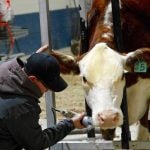EDMONTON – Consumers in Canada and abroad will drive the future direction of agriculture, says an American agricultural economist, and food safety will be one of their major concerns.
David Kohl of the Virginia Polytechnic Institute and State University of Virginia told an audience in Edmonton that consumers must have the ability to trace food from seed to plate and embryo to plate as an added assurance of safety.
“That’s not going to be an option, it’s going to be a necessity.”
Kohl said convenience is also going to be key to food in the future. In 1970, 30 percent of meals were eaten outside the home. It is now 46 percent and is expected to be 70 percent by 2015, by which time it will take only five minutes to prepare food at home because of higher incomes and improved technology.
Read Also

Trump cuts off trade talks with Canada
UPDATED: October 24, 2025 – 0910 CST – Adds comments from Prime Minister Mark Carney. Reuters — U.S. President Donald…
“Convenience is going to be extra, extra important.”
He said the days of eating three meals a day are already a thing of the past. Kohl estimated 30 percent of people eat 6.8 times a day and teenagers eat 16 times a day.
“Grazing is here.”
The trend to eating all day long has even shaped the way vehicles are designed, with the most important design in new cars being food trays, drink holders and microwaves for quick dining on the run.
Women will also be a major influence in the future of agriculture.
They now influence 63 percent of financial decisions and 80 percent of financial investment decisions on farms and ranches. In the United States and Canada, 60 percent of farmland is owned by women older than 65. Kohl called these people granny landlords.
“You better get in good with granny if you want to expand your operation.”
If there is one roadblock in agriculture’s transition to the new reality, it is a shortage of women on agricultural boards and co-operatives.
“One of the things I will tell you for strategic Alberta agriculture, you’ve got to get more women in leadership positions,” said Kohl, who used his university agriculture planning class as an example.
When he started teaching the class 25 years ago, only four percent of the students were women. The class is now 53 percent women.
“What I see is a major trend is going to be women in management positions, there’s no doubt about it. They’re going to bring new energy to the agriculture arena.”
On the farm, women will also play a heightened role in farm management, leadership roles and as liaisons with consumers.
Kohl said there are seven business models for farms of the future:
- Super commodity: Will range from 10,000 to 100,000 acres with at least $3 million of gross revenue. They will form strategic alliances with large food companies, will be tough negotiators and will focus on one or more commodities instead of diversifying.
- Traditional: A family farm model that will be challenged by its economies of scale and lifestyle because it’s too big to be small and too small to be big.
- Vertical integration: Such operations will control the process from production to finished product.
- Contract model: Will raise crop or livestock under contract.
- Lifestyle production: Will include 80 percent of farms. Will have little impact on crops, but a huge impact on politics. Most will be small acreages and must be 30 to 40 minutes drive from a mall. People move to these areas for the rural lifestyle, but maintain it with off-farm jobs.
- Value-added agriculture: Producers who exploit their location, production or service to gain extra value for their produce.
- Agri-entertainers: These producers sell their hunting or fishing rights, offer dude ranches or U-pick operations. They will offer a rural experience to city dwellers.














